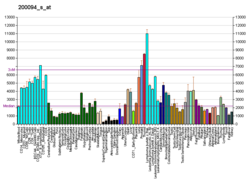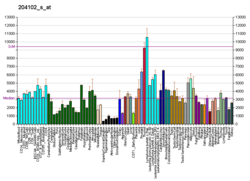EEF2
Eukaryotic elongation factor 2 is a protein that in humans is encoded by the EEF2 gene.[5][6][7]
This gene encodes a member of the GTP-binding translation elongation factor family. This protein is an essential factor for protein synthesis. It promotes the GTP-dependent translocation of the ribosome. This protein is completely inactivated by EF-2 kinase phosphorylation.[7]
It is the target of diphtheria toxin (from Corynebacterium diphtheriae), and exotoxin A (from Pseudomonas aeruginosa).[8] The inactivation of EF-2 by toxins inhibits protein production in the host, causing symptoms due to loss function in affected cells.
References
- ^ a b c GRCh38: Ensembl release 89: ENSG00000167658 – Ensembl, May 2017
- ^ a b c GRCm38: Ensembl release 89: ENSMUSG00000034994 – Ensembl, May 2017
- ^ "Human PubMed Reference:". National Center for Biotechnology Information, U.S. National Library of Medicine.
- ^ "Mouse PubMed Reference:". National Center for Biotechnology Information, U.S. National Library of Medicine.
- ^ Rapp G, Klaudiny J, Hagendorff G, Luck MR, Scheit KH (Mar 1990). "Complete sequence of the coding region of human elongation factor 2 (EF-2) by enzymatic amplification of cDNA from human ovarian granulosa cells". Biol Chem Hoppe Seyler. 370 (10): 1071–5. doi:10.1515/bchm3.1989.370.2.1071. PMID 2610926.
- ^ Kaneda Y, Yoshida MC, Kohno K, Uchida T, Okada Y (Jul 1984). "Chromosomal assignment of the gene for human elongation factor 2". Proc Natl Acad Sci U S A. 81 (10): 3158–62. doi:10.1073/pnas.81.10.3158. PMC 345240. PMID 6427766.
- ^ a b "Entrez Gene: EEF2 eukaryotic translation elongation factor 2".
- ^ Jørgensen R, Merrill AR, Andersen GR (February 2006). "The life and death of translation elongation factor 2". Biochem. Soc. Trans. 34 (Pt 1): 1–6. doi:10.1042/BST20060001. PMID 16246167.
Further reading
External links
- Peptide+Elongation+Factor+2 at the U.S. National Library of Medicine Medical Subject Headings (MeSH)






